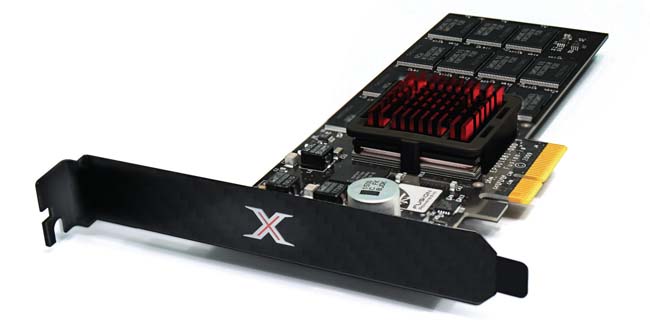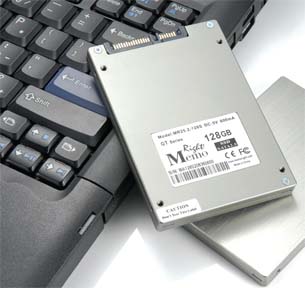Solid-State Drives: Speed and Efficiency
The advantages of systems from Fusion-IO, RocketDisk, Sun, and Texas Memory are many, but full integration is still a few years off.
Latest News
February 1, 2010
By Mark Clarkson
Solid-state drives (SSDs) have been a fringe technology ever since they were first displaced by spinning platter drives, back at the dawn of history. But that’s changing: in the past two years, tremendous development has taken place in modern SSDs.
 The ioXtreme from Fusion-io is a PCI Express solid-state drive that sits on the system bus, bypassing traditional disc interfaces. |
It seemed like high time to find out if a credible, solid-state replacement for the modern hard drive was finally here. The answer is yes … and no. And it depends on who you are.
SSDs are Fast
SSDs have a number of advantages, but primary among them is raw speed. Properly engineered and deployed, SSDs are very, very fast—orders of magnitude faster than spinning platter discs, depending on the application and the metric.
“Our devices reach eight to ten times the bandwidth of a normal disc drive,” says David Flynn of Fusion-IO. He explains, “the A10 Warthog fleet has been grounded because of stress cracks in the wings, and the Air Force is using Nastran ]FEA software] on a cluster to see why that should be. Those models were taking days to run. They brought the time down to several hours—about one-twelfth of the time—simply by changing the storage subsystem ]to Fusion-IO SSDs].”
 MemoRight SSDs from RocketDisk are designed to swap in for traditional hard drives. |
A Few Drawbacks
Compared to hard drives, SSDs are also rugged, cool, robust, and cheap to run. They require a tiny fraction of the power and cooling. What’s not to like?
For starters, there’s the price. For $100, I can put a terabyte (1,000 GB) hard drive in my workstation. That same money won’t even buy 64 GB of flash SSD. RAM-based SSDs are even more expensive.
Of course, very high-performance hard drives are much more expensive than $100 per terabyte but even so, in terms of cost-per-gigabyte, SSDs simply don’t currently make sense.
Despite being solid state, flash memory wears out. NAND flash has a life expectancy of somehere between 10,000 and 1,000,000 cycles. Reliability is a prevalent concern, but today’s enterprise solutions are very reliable.
But let’s reconsider that 10,000-cycle lifespan. How often do you actually fill up and empty your drive? If you write most data once per day, 10,000 cycles will last more than 25 years; that’s plenty of endurance for consumers.
On the other hand, “in the data center space,” says Flynn, “it may be thousands of cycles per day. So we use a different type of flash that can withstand millions of cycles.”
And remember this: disc drives fail too—you just never know when it’ll happen. “There’s a whole bunch of misinformation from the disc industry,” says Flynn, “because they’ve got a product that decays with a half-life of five years. An SSD might last five years, but you can guarantee how long it’s going to last.”
Flash memory is slower to write than it is to read, and performance can drop off steeply when drives begin to fill up. Properly engineered drives surmount all these problems via redundancy, error correction, RAM buffers, and smart engineering.
Three Orders of Magnitude SSDs really shine at I/O operations per second (IOPS). A fast hard drive will deliver in the neighborhood of 300 IOPS. A fast SSD will deliver in the neighborhood of 120K IOPS, an improvement of three orders of magnitude. The very fastest SSDs—based on DRAM rather than flash—can deliver a staggering 600K IOPS. —MC |
And many of these issues are peculiar to flash memory; not all SSDs use flash.
RAM Drives
“Assuming solid-state storage means flash is not correct,” says Neal Ekker, of Texas Memory Systems (TMS), manufacturer of RAM-based SSDs. “Is it a little nichy? Yes. But it’s real. That was our entire business until a year-and-a-half ago.
“The flash problems don’t exist. ]Our drives] can take all the reads and writes from now till hell freezes over, and they’ll all be at 15 microseconds. And it’s totally persistent. It’s as safe as any hard drive on the planet, probably more so.”
TMS’ RAM-based products back up to flash, and TMS now makes flash-based SSDs, as well.
The Form Factor Feud
Another consideration is packaging this new technology. If you stick it in a standard 3.5-in. enclosure with a SATA bus connector, you can tell the operating system it’s a hard drive and everything will just … work. The operating system and applications recognize it. You can boot from it. What’s not to like?
“For most customers it’s a no-brainer,” says Jonny Brownleader of SSD distributor, RocketDisk. “They simply switch the hard drive and change nothing else in their environment. Without much work or research, they eliminate the main bottleneck: the rotating, mechanical 25-year-old media.
“The majority of users don’t have the time or the budget to do anything other than switch hard drives around.”
Fusion-IO, on the other hand, takes a very different stance; their products plug into PCI Express slots. “Solid-state technologies,” says Flynn, “need to be connected closer to the system bus, so as to get unimpeded performance, and not be trapped behind SATA and SCSI.
Flynn adds, “We’ve deployed the flash directly on the system arteries, with unimpeded access to the system so you can get more performance in every dimension, not just minor dimensions as IOPS.”
RocketDisk’s Brownleader sees it differently: “In business, you’ve got to look ahead. But if you look too far ahead, and don’t concentrate on the need right now, you find yourself missing the boat. At the end of the day, we miss opportunities by not having the PCI Express option, but I feel we’d miss out on far more opportunities the other way.”
New Technology, and All that It Implies
“We’re embracing this technology,” says Michael Cornwell of Sun Microsystems. “We feel that it’s one of the most exciting things to happen in the server space for the last 25 years.”
But? “But you don’t see the type of improvement you could get if you assume a new type of storage medium.”
Developers, Cornwell says, are still writing applications that assume disc drives and SSDs are a whole ‘nother technology. For example, SSDs can perform up to 64 parallel operations. “Which means applications need multithreaded IO,” says Cornwell. “You had to do parallelization to take advantage of multiple processors; you’re going to have to do the same to take advantage of parallelization in SSDs.
“At the system level, we need better integration of SSDs into the architecture. And we’re going to need a high-speed standard, which doesn’t really exist today,” adds Cornwell. “We think SSDs are a couple of years from being a standard item that’s supported in every operating system.”
Is the End in Sight?
Depending on who you are and what you do, switching to SSDs could be an expensive disappointment or an instant moneymaker. Cheaper drives, especially those communicating via legacy disc interfaces such as SATA, can actually be slower in overall bandwidth. For now, tread carefully; know your application requirements and your vendor.
Solid-state storage does portend the death of traditional hard drives. But not just yet. The next five years will see SSDs penetrate further and further into enterprise and desktop storage, from above and below. In fact, by 2015, the hard drive will be as passé as the floppy drive.
Hard drives won’t go away entirely for some time after that; tape drives are still around, though you probably don’t have one on your desktop. Hard drives are the tape drives of the future.
More Info:
Fusion-IO
Contributing Editor Mark Clarkson is DE’s expert in visualization, computer animation, and graphics. His newest book is “Photoshop Elements by Example.” Visit him on the web at markclarkson.com or send e-mail about this article to [email protected].
Subscribe to our FREE magazine, FREE email newsletters or both!
Latest News
About the Author
Mark ClarksonContributing Editor Mark Clarkson is Digital Engineering’s expert in visualization, computer animation, and graphics. His newest book is Photoshop Elements by Example. Visit him on the web at MarkClarkson.com or send e-mail about this article to [email protected].
Follow DE





